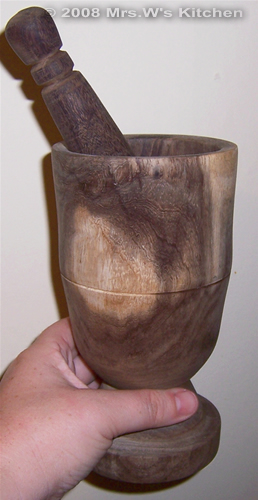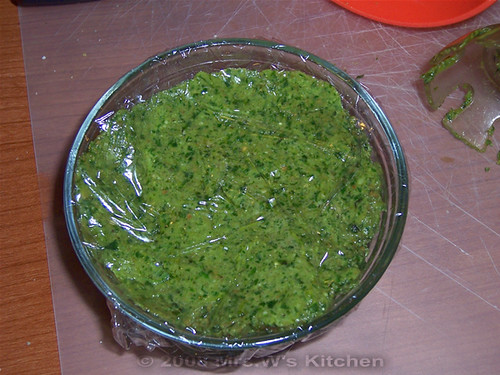Pesto is one of the most versatile ingredients you can have on-hand in your kitchen. While available in bottles and jars everywhere, this is easily made at home.
Basically a puree of basil, garlic, salt, and often olive oil, cheese and pine nuts or other nuts/seeds, pesto is a gem to have around. It can be used as a sauce for pasta, a spread on bread, or as an ingredient in any number of dips, spreads, soups and sauces. Anywhere you want to add some basil and garlic flavor, pesto can be used. It also keeps well in the freezer in pre-measured amounts.
I love my local farmer's market, especially because a woman I know (we went to high school together) sells herbs there. Her herbs are grown organically, and she'll separate a bunch for you if you ask for only $1 worth. And $1 worth gave me 1-1/2 cups of basil--the perfect amount for a batch of pesto.
I make a thick, paste-like pesto, to which I can add additional oil for a sauce, or simply stir its thickness into any number of recipes. And while I'm usually all about quick & easy, I take a slightly different route when making mine. I start with my most favorite mortar and pestle.

I bought this gem while travelling in South Africa. Years of watching Jamie Oliver bash ingredients together in his mortar & pestle chased away my fears, and once I had this handy-dandy tool, I never looked back.
I use my mortar and pestle for many things, but more often than not it is used for making garlic paste. Salt and garlic are mashed together into one gorgeous entity that cannot be duplicated in a food processor.
While pesto was originally made entirely in a mortar and pestle, today we have the modern convenience of electric kitchen tools. Like making garlic paste, I'm sure the taste isn't as perfect, but I've tried making pesto in the mortar and pestle, and, well, that's just too much like work.

Pesto
yield: about 3/4 cup, very thick consistency
- 1 clove garlic, bashed into a paste in a mortar and pestle with a pinch of salt (or just add garlic & pinch salt when processing rest of ingredients)
- 1-1/2 cups basil leaves, washed and dried
- 1/4 cup toasted pine nuts (or other nuts as desired; I used sunflower seeds because I have them on-hand)
- scant 1/4 cup parmigiano-reggiano cheese (may substitute pecorino or other hard italian cheese, if desired)
- 1/2 teaspoon ground black pepper
- 1/4 cup extra-virgin olive oil
Combine all ingredients in a food processor or blender and process until smooth. Alternatively, combine everything in a high-sided container and puree using a hand blender. You may need to add a bit more oil to reach the consistency you desire.
Pesto will oxidize quickly and turn into an icky greyish brown. If that happens to you, don't worry too much about it--it's still perfectly fine to eat. But to avoid such a problem, make pesto in small batches just before using. Any extra should be frozen in teaspoon- or tablespoon-sized portions; it can also be refrigerated covered by a thin layer of oil for no longer than 1 week.
Try making other kinds of pesto--use half basil and half oregano for a change. Try different nuts and seeds. How about a cilantro version (say, cilantro, garlic, shallot and olive oil) for your favorite hispanic-inspired meals? Sounds yummy to me!




No comments:
Post a Comment